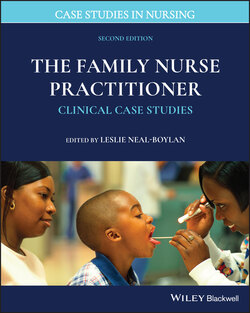Читать книгу The Family Nurse Practitioner - Группа авторов - Страница 60
ОглавлениеCase 6.7 Sexual Assault
By Meredith Scannell, PhD, MSN, MPH, CNM, CEN, SANE‐A
SUBJECTIVE
Aiyata is a 22‐year‐old female who presents requesting treatment for sexually transmitted infection. She reports she recently graduated from college and was out celebrating the graduation with some friends last night. She reports going to a bar where she met with a male friend who bought her drinks. She has a vague recollection of the night but awoke today naked in the bed with the male friend. She has a vague memory of having sex with the male friend but does not recall many of the details; she is not sure if a condom was used. She is concerned because she has been having vaginal spotting since the event and some pain and discomfort in the vagina.
Past medical history: Depression, childhood sexual abuse, post‐traumatic stress disorder.
Past surgical history: None.
Menstrual history: LMP 2 weeks ago; she reports a 28‐day cycle and no menstrual irregularities.
Genitourinary: Reports some dysuria that started this morning.
Family history: Aiyata’s mother has a history of alcohol abuse and hypertension. Her father’s history is unknown.
Social history: Aiyata was raised in a single‐parent home with her mother as the primary caregiver. She is currently living in an apartment with college friends. Aiyata recently graduated from college and works part‐time as a server. She reports being single since a breakup with her boyfriend. She had been in a mutually monogamous relationship with the boyfriend, but since the breakup, she has had 3 casual sexual partners. She practices safe sex with the use of condoms.
Substance use: She occasionally consumes alcohol 1–2 times a week with 1–2 drinks per setting. She admits to occasional marijuana consumption, but uses no other recreational drugs.
Medications: Oral contraception, Citalopram 20 mg daily.
Allergies: No known drug allergies.
OBJECTIVE
General: Ayita is sad appearing, talking softly, answering questions appropriately.
Vital signs: Temperature: 98.6°F; BP: 120/74; HR: 99; RR: 18.
Skin: Abrasion on left knee and left elbow.
Neurologic: Alert and oriented × 3
HEENT:
Head: Nontender, without masses, hair normally distributed.
Neck: Lateral neck tender to palpation; dark red ecchymosed areas on right side of neck, trachea midline, no lymphadenopathy. Thyroid nontender, without palpable masses or enlargement.
Eyes: PERRLA and EOMs are intact, left eye small subconjunctival hemorrhage.
Oropharynx: Uvula is midline, no edema, redness, or ecchymosis.
Respiratory: Lung sounds are clear to auscultate.
Cardiac: Regular rate and rhythm.
Breast: Tanner IV, symmetrical.
Abdomen: Soft, nontender, nondistended; active bowel sounds.
Pelvic:
Vulva: No lesions or ecchymosis. The labia minora are red and swollen, tender to palpation; there is a small laceration at the posterior fourchette.
Vagina: No active bleeding, very tender with speculum insertion, white discharge in vaginal vault.
Cervix: Bright red and friable; positive cervical motion tenderness.
Rectal: Rugae normal appearance, no lesions.
CRITICAL THINKING
1 What is the most likely differential diagnosis in this case and why?___Sexual assault___Strangulation___Pelvic inflammatory disease
2 Which diagnostic tests are required in this case and why?___CBC with differential___Metabolic panel___LFTs___Toxicology panel___HCG___HIV___Urinalysis___NAAT___CT scan neck___Transvaginal ultrasound___Abdominal ultrasound
3 What are the concerns at this point?
4 What is the plan of treatment?
5 What are the plans for referral and follow‐up care?
6 What health education should be provided to this patient?
7 Are there any standardized guidelines that should be used to assess or treat this case?
